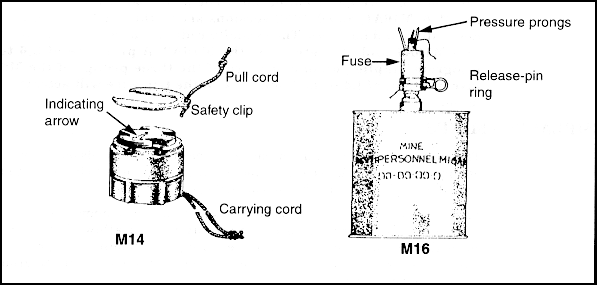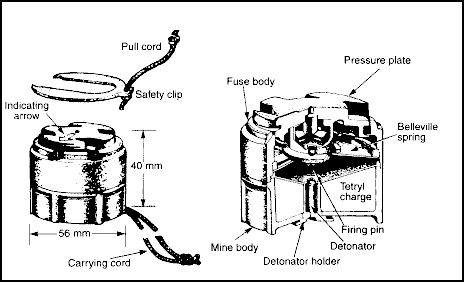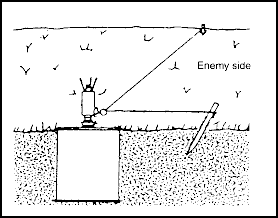DESCRIPTION:
The M14 is a non-metallic, blast-type AP mine consisting of a main charge of tetryl (1 ounce). The mine is cylindrical in shape, 2-3/16 inches in diameter and 1-9/16 inches high weighing approximately 3-1/2 pounds. The M14 is not designed to kill, but to incapacitate. The M14 AP mine has been modified by gluing a metal washer to the bottom of the mine. The modification was directed to improve the detectability of the mine. Unmodified mines are not authorized for use by US forces. The M16 is a bounding fragmentation type mine consisting of a mine fuse, a propelling charge and a projectile in a sheetmetal case. The mine is approximately 4 inches in diameter, 7-5/8 inches in height with the fuse installed, and weighs 7-7/8 pounds. Pressure of between 8 and 20 pounds acting on one or more of the three prongs of the fuse, or pull of between 3 and 10 pounds on a tripwire attached to the release, will activate the mine. The principal difference between the M16, M16A1, and M16A2 versions are in the construction of the detonators and boosters. The casualty radius is 27 meters for the M16 and M16A1 and 30 meters for the M16A2. A pressure of 3.6 to 9 kilograms applied on one or more of the three prongs of the M605 fuse or a pull of 1.4 to 4.5 kilograms on the trip wire will activate the mine.
STATUS: The M14 was fielded in the early 1950s and last procured in 1974. The M16 and M18 were fielded in the early 1960s. Sufficient mine assets are available to support requirements. There are no plans to purchase additional quantities of these AP mines.
EMPLOYMENT CONCEPT: The M14 and M16 AP mines are used with other natural and artificial obstacles to increase obstacle effectiveness. They are also employed in standard-pattern minefields to protect against breaching of anti-tank (AT) mines or by themselves to defeat and demoralize dismounted personnel. They are employed to block the most likely enemy approaches, protect a flank or keep the enemy from key terrain.
BASIS OF ISSUE: AP mines are Class V item of issue. Combat and Combat Support units may be authorized a basic load of AP mines contingent upon their mission. Combat Engineer units will draw from pre-stock points or Ammunition Transfer Points as needed for the development and execution of the obstacle plan.
TRAINING/PERSONNEL: Initial training is taught at all Combat and Combat Support Schools. Inert practice mines are used to teach the required skills of emplacing, recognizing and removing mines. Soldiers maintain minelaying proficiency through unit training utilizing Soldier's Manual standards.





